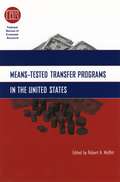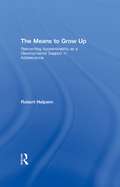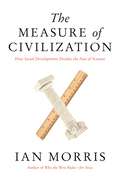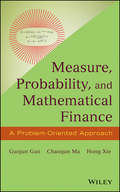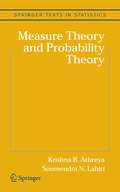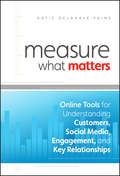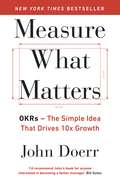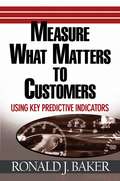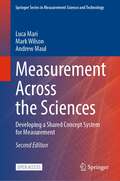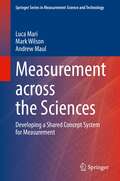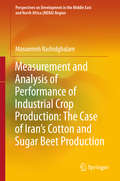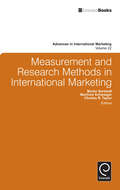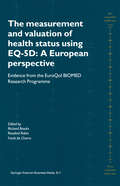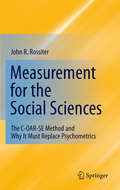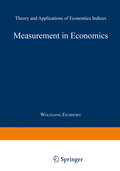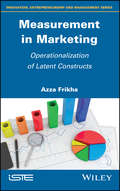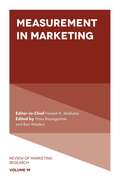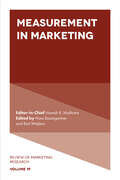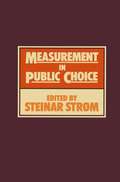- Table View
- List View
Means-Tested Transfer Programs in the United States (National Bureau of Economic Research Conference Report)
by Robert MoffittFew United States government programs are as controversial as those designed to aid the poor. From tax credits to medical assistance, aid to needy families is surrounded by debate—on what benefits should be offered, what forms they should take, and how they should be administered. The past few decades, in fact, have seen this debate lead to broad transformations of aid programs themselves, with Aid to Families with Dependent Children replaced by Temporary Assistance to Needy Families, the Earned Income Tax Credit growing from a minor program to one of the most important for low-income families, and Medicaid greatly expanding its eligibility. This volume provides a remarkable overview of how such programs actually work, offering an impressive wealth of information on the nation's nine largest "means-tested" programs—that is, those in which some test of income forms the basis for participation. For each program, contributors describe origins and goals, summarize policy histories and current rules, and discuss the recipient's characteristics as well as the different types of benefits they receive. Each chapter then provides an overview of scholarly research on each program, bringing together the results of the field's most rigorous statistical examinations. The result is a fascinating portrayal of the evolution and current state of means-tested programs, one that charts a number of shifts in emphasis—the decline of cash assistance, for instance, and the increasing emphasis on work. This exemplary portrait of the nation's safety net will be an invaluable reference for anyone interested in American social policy.
Means-Tested Transfer Programs in the United States (National Bureau of Economic Research Conference Report)
by Robert A. Moffitt National Bureau of Economic Research StaffFew United States government programs are as controversial as those designed to aid the poor. From tax credits to medical assistance, aid to needy families is surrounded by debate—on what benefits should be offered, what forms they should take, and how they should be administered. The past few decades, in fact, have seen this debate lead to broad transformations of aid programs themselves, with Aid to Families with Dependent Children replaced by Temporary Assistance to Needy Families, the Earned Income Tax Credit growing from a minor program to one of the most important for low-income families, and Medicaid greatly expanding its eligibility. This volume provides a remarkable overview of how such programs actually work, offering an impressive wealth of information on the nation's nine largest "means-tested" programs—that is, those in which some test of income forms the basis for participation. For each program, contributors describe origins and goals, summarize policy histories and current rules, and discuss the recipient's characteristics as well as the different types of benefits they receive. Each chapter then provides an overview of scholarly research on each program, bringing together the results of the field's most rigorous statistical examinations. The result is a fascinating portrayal of the evolution and current state of means-tested programs, one that charts a number of shifts in emphasis—the decline of cash assistance, for instance, and the increasing emphasis on work. This exemplary portrait of the nation's safety net will be an invaluable reference for anyone interested in American social policy.
The Means to Grow Up: Reinventing Apprenticeship as a Developmental Support in Adolescence (Critical Youth Studies)
by Robert HalpernIn The Means to Grow Up, Robert Halpern describes the pedagogical importance of "apprenticeship"—a growing movement based in schools, youth-serving organizations, and arts, civic, and other cultural institutions. This movement aims to re-engage youth through in-depth learning and unique experiences under the guidance of skilled professionals. Employing a "pedagogy of apprenticeship," these experiences combine specific, visceral, and sometimes messy work with opportunity for self-expression, increasing responsibility, and exposure to the adult world. Grounded in ethnographic studies, The Means to Grow Up illustrates how students work in unique ways around these meaningful activities and projects across a range of disciplines. Participation in these efforts strengthens skills, dispositions, and self-knowledge that is critical to future schooling and work, renews young peoples’ sense of vitality, and fosters a grounded sense of accomplishment. In unearthing the complexities of apprenticeship learning, Halpern challenges the education system that is increasingly geared towards the acquisition of de-contextualized skills. Instead, he reveals how learning alongside experienced adults can be a profoundly challenging and complex endeavor for adolescents and offers readers an exciting vision of what education can and should be about.
The Means to Grow Up: Reinventing Apprenticeship as a Developmental Support in Adolescence (Critical Youth Studies)
by Robert HalpernIn The Means to Grow Up, Robert Halpern describes the pedagogical importance of "apprenticeship"—a growing movement based in schools, youth-serving organizations, and arts, civic, and other cultural institutions. This movement aims to re-engage youth through in-depth learning and unique experiences under the guidance of skilled professionals. Employing a "pedagogy of apprenticeship," these experiences combine specific, visceral, and sometimes messy work with opportunity for self-expression, increasing responsibility, and exposure to the adult world. Grounded in ethnographic studies, The Means to Grow Up illustrates how students work in unique ways around these meaningful activities and projects across a range of disciplines. Participation in these efforts strengthens skills, dispositions, and self-knowledge that is critical to future schooling and work, renews young peoples’ sense of vitality, and fosters a grounded sense of accomplishment. In unearthing the complexities of apprenticeship learning, Halpern challenges the education system that is increasingly geared towards the acquisition of de-contextualized skills. Instead, he reveals how learning alongside experienced adults can be a profoundly challenging and complex endeavor for adolescents and offers readers an exciting vision of what education can and should be about.
The Measure of Civilization: How Social Development Decides the Fate of Nations
by Ian MorrisIn the last thirty years, there have been fierce debates over how civilizations develop and why the West became so powerful. The Measure of Civilization presents a brand-new way of investigating these questions and provides new tools for assessing the long-term growth of societies. Using a groundbreaking numerical index of social development that compares societies in different times and places, award-winning author Ian Morris sets forth a sweeping examination of Eastern and Western development across 15,000 years since the end of the last ice age. He offers surprising conclusions about when and why the West came to dominate the world and fresh perspectives for thinking about the twenty-first century. Adapting the United Nations' approach for measuring human development, Morris's index breaks social development into four traits--energy capture per capita, organization, information technology, and war-making capacity--and he uses archaeological, historical, and current government data to quantify patterns. Morris reveals that for 90 percent of the time since the last ice age, the world's most advanced region has been at the western end of Eurasia, but contrary to what many historians once believed, there were roughly 1,200 years--from about 550 to 1750 CE--when an East Asian region was more advanced. Only in the late eighteenth century CE, when northwest Europeans tapped into the energy trapped in fossil fuels, did the West leap ahead. Resolving some of the biggest debates in global history, The Measure of Civilization puts forth innovative tools for determining past, present, and future economic and social trends.
The Measure of Civilization: How Social Development Decides the Fate of Nations
by Ian MorrisIn the last thirty years, there have been fierce debates over how civilizations develop and why the West became so powerful. The Measure of Civilization presents a brand-new way of investigating these questions and provides new tools for assessing the long-term growth of societies. Using a groundbreaking numerical index of social development that compares societies in different times and places, award-winning author Ian Morris sets forth a sweeping examination of Eastern and Western development across 15,000 years since the end of the last ice age. He offers surprising conclusions about when and why the West came to dominate the world and fresh perspectives for thinking about the twenty-first century. Adapting the United Nations' approach for measuring human development, Morris's index breaks social development into four traits--energy capture per capita, organization, information technology, and war-making capacity--and he uses archaeological, historical, and current government data to quantify patterns. Morris reveals that for 90 percent of the time since the last ice age, the world's most advanced region has been at the western end of Eurasia, but contrary to what many historians once believed, there were roughly 1,200 years--from about 550 to 1750 CE--when an East Asian region was more advanced. Only in the late eighteenth century CE, when northwest Europeans tapped into the energy trapped in fossil fuels, did the West leap ahead. Resolving some of the biggest debates in global history, The Measure of Civilization puts forth innovative tools for determining past, present, and future economic and social trends.
Measure, Probability, and Mathematical Finance: A Problem-Oriented Approach
by Guojun Gan Chaoqun Ma Hong XieAn introduction to the mathematical theory and financial models developed and used on Wall Street Providing both a theoretical and practical approach to the underlying mathematical theory behind financial models, Measure, Probability, and Mathematical Finance: A Problem-Oriented Approach presents important concepts and results in measure theory, probability theory, stochastic processes, and stochastic calculus. Measure theory is indispensable to the rigorous development of probability theory and is also necessary to properly address martingale measures, the change of numeraire theory, and LIBOR market models. In addition, probability theory is presented to facilitate the development of stochastic processes, including martingales and Brownian motions, while stochastic processes and stochastic calculus are discussed to model asset prices and develop derivative pricing models. The authors promote a problem-solving approach when applying mathematics in real-world situations, and readers are encouraged to address theorems and problems with mathematical rigor. In addition, Measure, Probability, and Mathematical Finance features: A comprehensive list of concepts and theorems from measure theory, probability theory, stochastic processes, and stochastic calculus Over 500 problems with hints and select solutions to reinforce basic concepts and important theorems Classic derivative pricing models in mathematical finance that have been developed and published since the seminal work of Black and Scholes Measure, Probability, and Mathematical Finance: A Problem-Oriented Approach is an ideal textbook for introductory quantitative courses in business, economics, and mathematical finance at the upper-undergraduate and graduate levels. The book is also a useful reference for readers who need to build their mathematical skills in order to better understand the mathematical theory of derivative pricing models.
Measure, Probability, and Mathematical Finance: A Problem-Oriented Approach
by Guojun Gan Chaoqun Ma Hong XieAn introduction to the mathematical theory and financial models developed and used on Wall Street Providing both a theoretical and practical approach to the underlying mathematical theory behind financial models, Measure, Probability, and Mathematical Finance: A Problem-Oriented Approach presents important concepts and results in measure theory, probability theory, stochastic processes, and stochastic calculus. Measure theory is indispensable to the rigorous development of probability theory and is also necessary to properly address martingale measures, the change of numeraire theory, and LIBOR market models. In addition, probability theory is presented to facilitate the development of stochastic processes, including martingales and Brownian motions, while stochastic processes and stochastic calculus are discussed to model asset prices and develop derivative pricing models. The authors promote a problem-solving approach when applying mathematics in real-world situations, and readers are encouraged to address theorems and problems with mathematical rigor. In addition, Measure, Probability, and Mathematical Finance features: A comprehensive list of concepts and theorems from measure theory, probability theory, stochastic processes, and stochastic calculus Over 500 problems with hints and select solutions to reinforce basic concepts and important theorems Classic derivative pricing models in mathematical finance that have been developed and published since the seminal work of Black and Scholes Measure, Probability, and Mathematical Finance: A Problem-Oriented Approach is an ideal textbook for introductory quantitative courses in business, economics, and mathematical finance at the upper-undergraduate and graduate levels. The book is also a useful reference for readers who need to build their mathematical skills in order to better understand the mathematical theory of derivative pricing models.
Measure Theory and Probability Theory (Springer Texts in Statistics)
by Krishna B. Athreya Soumendra N. LahiriThis is a graduate level textbook on measure theory and probability theory. It presents the main concepts and results in measure theory and probability theory in a simple and easy-to-understand way. It further provides heuristic explanations behind the theory to help students see the big picture. The book can be used as a text for a two semester sequence of courses in measure theory and probability theory, with an option to include supplemental material on stochastic processes and special topics. Prerequisites are kept to the minimal level and the book is intended primarily for first year Ph.D. students in mathematics and statistics.
Measure What Matters: Online Tools For Understanding Customers, Social Media, Engagement, and Key Relationships
by Katie Delahaye PaineIn an online and social media world, measurement is the key to success If you can measure your key business relationships, you can improve them. Even though relationships are "fuzzy and intangible," they can be measured and managed-with powerful results. Measure What Matters explains simple, step-by-step procedures for measuring customers, social media reputation, influence and authority, the media, and other key constituencies. Based on hundreds of case studies about how organizations have used measurement to improve their reputations, strengthen their bottom lines, and improve efficiencies all around Learn how to collect the data that will help you better understand your competition, do strategic planning, understand key strengths and weaknesses, and better respond to customer preferences Author runs a successful blog and serves as a measurement consultant to companies such as Facebook, Southwest Airlines, Raytheon, and Allstate Don't draw conclusions or make key decisions based on guesswork. Instead, Measure What Matters and the difference will show in the most important measure: your bottom line.
Measure What Matters: Online Tools For Understanding Customers, Social Media, Engagement, and Key Relationships
by Katie Delahaye PaineIn an online and social media world, measurement is the key to success If you can measure your key business relationships, you can improve them. Even though relationships are "fuzzy and intangible," they can be measured and managed-with powerful results. Measure What Matters explains simple, step-by-step procedures for measuring customers, social media reputation, influence and authority, the media, and other key constituencies. Based on hundreds of case studies about how organizations have used measurement to improve their reputations, strengthen their bottom lines, and improve efficiencies all around Learn how to collect the data that will help you better understand your competition, do strategic planning, understand key strengths and weaknesses, and better respond to customer preferences Author runs a successful blog and serves as a measurement consultant to companies such as Facebook, Southwest Airlines, Raytheon, and Allstate Don't draw conclusions or make key decisions based on guesswork. Instead, Measure What Matters and the difference will show in the most important measure: your bottom line.
Measure What Matters: OKRs: The Simple Idea that Drives 10x Growth
by John DoerrNEW YORK TIMES BESTSELLER AS SEEN ON GATES NOTES - 'I'd recommend John's book for anyone interested in becoming a better manager', Bill Gates'Management magic....Measure What Matters is a must read for anyone motivated to improve their organization' - Former Vice President Al Gore, chairman of the Climate Reality Project'Measure What Matters shows how any organization or team can aim high, move fast, and excel' , Sheryl Sandberg, Facebook COO and founder of Leanln.org and OptionB.org 'Measure What Matters deserves to be fully embraced by every person responsible for performance in any walk of life' - Jim Collins, author of Good to Great 'In this indispensable book, the most important venture capitalist of our era reveals a key to business innovation and success - Walter Isaacson, author of Steve Jobs and The Innovators 'Measure What Matters takes you behind the scenes for the creation of Intel's powerful OKR system - one of Andy Grove's finest legacies' - Gordon Moore, cofounder and former chairman of Intel --------The revolutionary movement behind the explosive growth of Intel, Google, Amazon and Uber. With a foreword by Larry Page, and contributions from Bono and Bill Gates. Measure What Matters is about using Objectives and Key Results (OKRs), a revolutionary approach to goal-setting, to make tough choices in business. In 1999, legendary venture capitalist John Doerr invested nearly $12 million in a startup that had amazing technology, entrepreneurial energy and sky-high ambitions, but no real business plan. Doerr introduced the founders to OKRs and with them at the foundation of their management, the startup grew from forty employees to more than 70,000 with a market cap exceeding $600 billion. The startup was Google. Since then Doerr has introduced OKRs to more than fifty companies, helping tech giants and charities exceed all expectations. In the OKR model objectives define what we seek to achieve and key results are how those top priority goals will be attained. OKRs focus effort, foster coordination and enhance workplace satisfaction. They surface an organization's most important work as everyone's goals from entry-level to CEO are transparent to the entire institution. In Measure What Matters, Doerr shares a broad range of first-person, behind-the-scenes case studies, with narrators including Bono and Bill Gates, to demonstrate the focus, agility, and explosive growth that OKRs have spurred at so many great organizations. This book will show you how to collect timely, relevant data to track progress - to measure what matters. It will help any organization or team aim high, move fast, and excel. -------- John Doerr joined Kleiner Perkins Caufield & Byers in 1980 and has since backed some of the world's most successful entrepreneurs and companies, such as Google, Zynga and Amazon. John serves on the boards of Google, Zynga and Amyris. He also led KPCB's investment in Twitter. He is a member of the American Academy of Arts and Sciences, and was a member of U.S. President Barack Obama's Council on Jobs and Competitiveness. He has 291K followers on Twitter. His TED Talk on greentech has 896K views.
Measure What Matters to Customers: Using Key Predictive Indicators (KPIs)
by Ronald J. BakerMeasure What Matters to Customers reveals how to capitalize on Key Predictive Indicators (KPIs), the innovative measures that define the success of your enterprise as your customers do. If you want to increase your company's profits by working smarter, this is the book for you.
Measurement Across the Sciences: Developing a Shared Concept System for Measurement (Springer Series in Measurement Science and Technology)
by Luca Mari Mark Wilson Andrew MaulThis open access book proposes a conceptual framework for understanding measurement across a broad range of scientific fields and areas of application, such as physics, engineering, education, and psychology. It addresses contemporary issues and controversies within measurement in light of the framework, including operationalism, definitional uncertainty, and the relations between measurement and computation, and describes how the framework, operating as a shared concept system, supports understanding measurement’s work in different domains, using examples in the physical and human sciences.This revised and expanded second edition features a new analysis of the analogies and the differences between the error/uncertainty-related approach adopted in physical measurement and the validity-related approach adopted in psychosocial measurement. In addition, it provides a better analysis and presentation of measurement scales, in particular about their relations with quantity units, and introduces the measurand identification/definition as a part of the "Hexagon Framework" along with new examples from the physical and psychosocial sciences. Researchers and academics across a wide range of disciplines including biological, physical, social, and behavioral scientists, as well as specialists in measurement and philosophy appreciate the work’s fresh and provocative approach to the field at a time when sound measurements of complex scientific systems are increasingly essential to solving critical global problems.
Measurement across the Sciences: Developing a Shared Concept System for Measurement (Springer Series in Measurement Science and Technology)
by Mark Wilson Luca Mari Andrew MaulThis book proposes a conceptual framework for understanding measurement across a broad range of scientific fields and areas of application, such as physics, engineering, education, and psychology. The authors, who themselves span these disciplines, argue that the justification of the public trust attributed to measurement results can in principle apply identically to both physical and psychosocial properties. They further argue that the lack of a common conceptualization of measurement hampers interdisciplinary communication and limits the ability to share knowledge. They advance their views by first surveying the conceptual history of the philosophy of measurement and arguing that classical, operationalist and representational perspectives on measurement each make important contributions but also each have important shortcomings. A synthesis is then offered as the foundation for a new conceptual framework. The authors describe how the framework, which operates as a shared concept system, supports understanding measurement’s work in different domains, using examples in the physical and human sciences. They consider connections and consequences with respect to causality, objectivity, and intersubjectivity, among other topics, and how measurement science concepts and issues are construed across these disciplines and settings. They also address contemporary issues and controversies within measurement in the light of the framework, including operationalism, definitional uncertainty, and the relations between measurement and computation. The book concludes with a justification for the basic claim that measurement is an empirical and informational process that produces explicitly justifiable information. Researchers and academics across a wide range of disciplines including biological, physical, social and behavioral scientists, as well as specialists in measurement and philosophy will appreciate the work’s fresh and provocative approach to the field at a time when sound measurements of complex scientific systems are increasingly essential to solving critical global problems.
Measurement and Analysis of Performance of Industrial Crop Production: The Case of Iran’s Cotton and Sugar Beet Production (Perspectives on Development in the Middle East and North Africa (MENA) Region)
by Masoomeh RashidghalamThis book employs different parametric and non-parametric panel data models which have been used in history of developed panel data efficiency measurement literature. It assesses the differences of models based on characteristics and efficiency scores measurement using a systematic sensitivity analysis of the results. On the whole twelve parametric and four nonparametric models were studied. Parametric models are classified in four groups in terms of the assumptions made on the temporal behavior of inefficiency. A common issue among all the parametric models is that inefficiency is individual producer-specific. This is consistent with the notion of measuring the efficiency of decision-making units. Non-parametric models are divided into partial and full frontier models. A main contribution of this volume is that it helps to understand differences between parametric and non-parametric models. On empirical part of the volume, technical efficiency of two agricultural strategic crops (cotton and sugar beet) in different provinces of the Iran are analyzed. Using different models, the most efficient and inefficient provinces in cotton and sugar beet production of Iran are recognized.
Measurement and Research Methods in International Marketing (Advances in International Marketing #22)
by Marko Sarstedt Manfred Schwaiger Charles R. Taylor Shaoming ZouPublishing cross-national research is often a difficult endeavour as ensuring equivalence of method and measures can be challenging. Even though the importance of sound data and valid measures has long been an acknowledged, it is often problematic to follow required quality standards in concrete research situations. Against this background, this volume addresses issues pertaining to measurement and research methodology in an international marketing context. Written by a group of internationally renowned scholars, the papers address a broad range of subjects including response-bias in cross-cultural research, problems with cultural distance measures, and construct specification. Others focus on the development and application of novel research methods, for example in the context of marketing efficiency measurement or international market segmentation. Collectively, the papers in this volume substantially further marketing knowledge and provide fruitful avenues for future research. As such, this volume is an invaluable asset to researchers, students and practitioners in this particular field.
The Measurement and Valuation of Health Status Using EQ-5D: Evidence from the EuroQol BIOMED Research Programme
by FrankCharro RosalindRabin RichardBrooksEQ-5D from the EuroQol Group is a standardised, non-disease-specific instrument for describing and valuing health. It is in widespread use in many countries and has been applied in many different settings. EQ-5D is now an integral feature of many clinical trials and is increasingly used in population health surveys. This book reports on the results of the European Union-funded EQ-net project which furthered the development of EQ-5D in the key areas of valuation, application and translation. The primary effort concentrated on harmonising and integrating the results of the various EuroQol valuation projects. Most importantly, the book includes a set of VAS-based preference weights for all the EQ-5D health states based on cross-European EQ-5D data. This book provides the most comprehensive account to date of the EuroQol Group endeavour. It will appeal to clinicians, nurses, health services researchers, health economists, those responsible for audit and quality assurance, public health specialists and managers in health care institutions, and the pharmaceutical industry.
Measurement for the Social Sciences: The C-OAR-SE Method and Why It Must Replace Psychometrics
by John R. RossiterThis book proposes a revolutionary new theory of construct measurement – called C-OAR-SE – for the social sciences. The acronym is derived from the following key elements: construct definition; object representation; attribute classification; rater entity identification; selection of item type; enumeration and scoring. The new theory is applicable to the design of measures of constructs in: • Management • Marketing • Information Systems • Organizational Behavior • Psychology • Sociology C-OAR-SE is a rationally rather than empirically-based theory and procedure. It can be used for designing measures of the most complex and also the most basic constructs that we use in social science research. C-OAR-SE is a radical alternative to the traditional empirically-based psychometric approach, and a considerable amount of the book’s content is devoted to demonstrating why the psychometric approach does not produce valid measures. The book argues that the psychometric approach has resulted in many misleading findings in the social sciences and has led to erroneous acceptance – or rejection – of many of our main theories and hypotheses, and that the C-OAR-SE approach to measurement would correct this massive problem. The main purpose of this book is to introduce and explain C-OAR-SE construct measurement theory in a way that will be understood by all social science researchers and that can be applied to designing new, more valid measures. Featuring numerous examples, practical applications, end-of-chapter questions, and appendices, the book will serve as an essential resource for students and professional researcher alike.
Measurement in Economics: Theory and Applications of Economics Indices
by Wolfgang EichhornFirst discussions on several topics of this book took place at a symposium held at the University of Karlsruhe (July 14 - 21, 1985). The book is divided into nine parts with the headings "Methodology and Methods" (4 papers), "Prices" (9), "Efficiency" (5), "Preferences" (7), "Quality" (2), "Inequality" (6), "Taxation" (6), "Aggregation" (6), and "Econometrics" (6). The topics range from the "equation of measurement", a functional equation which plays an important role in the subject, through various approaches to price, efficiency, inequality and tax progression measurement to results on consistency, efficiency and separability in aggregation, productivity measurement, cost functions, allocation inefficiencies, key sector indices, and testing of integrability conditions in econometrics. There are applications to the economies of the U.S.A., Japan and Germany. It contains also papers which deal with preferences, environmental quality and with noxiousness of substances.
Measurement in Marketing: Operationalization of Latent Constructs
by Azza FrikhaScientific research uses concepts (or constructs) and requires means to measure them. Often latent, abstract and not directly observable, these concepts demand special attention. When facing problems related to their operationalization, considerable efforts are required to construe measures that effectively represent the phenomena studied. Measurement in Marketing presents a wide range of ideas to help researchers in the selection, design and validation of measurements of constructs. It analyzes the provisions that must be implemented to allow the transition from a latent conceptual construct to an operational level close to reality, and thus to make possible a fluid, reliable and valid reading of the phenomena observed. This instructive book guides readers through all stages of the implementation of a measure. It is intended for a wide audience, offering examples, summary tables and boxes in order to emphasize the primary information.
Measurement in Marketing: Operationalization of Latent Constructs
by Azza FrikhaScientific research uses concepts (or constructs) and requires means to measure them. Often latent, abstract and not directly observable, these concepts demand special attention. When facing problems related to their operationalization, considerable efforts are required to construe measures that effectively represent the phenomena studied. Measurement in Marketing presents a wide range of ideas to help researchers in the selection, design and validation of measurements of constructs. It analyzes the provisions that must be implemented to allow the transition from a latent conceptual construct to an operational level close to reality, and thus to make possible a fluid, reliable and valid reading of the phenomena observed. This instructive book guides readers through all stages of the implementation of a measure. It is intended for a wide audience, offering examples, summary tables and boxes in order to emphasize the primary information.
Measurement in Marketing (Review of Marketing Research #19)
by Naresh K. MalhotraMeasurement is at the core of empirical research in marketing because researchers need measures that faithfully represent the constructs in their theories. This 19th volume of Review of Marketing Research addresses important measurement issues to deepen readers’ appreciation of the fundamental role of measurement in empirical research in marketing. Measurement in Marketing features a range of chapters from experts in the field who discuss the philosophical foundations of measurement, provide practical recommendations about measurement error and explore the latest research, offering guidance on the selection of appropriate implicit measures for capturing automatic cognitive processes. Measurement in Marketing is built to provide a state-of-the-art discussion of current topics in measurement and deepen readers’ appreciation of the fundamental role of measurement in empirical research in marketing.
Measurement in Marketing (Review of Marketing Research #19)
by Naresh K. MalhotraMeasurement is at the core of empirical research in marketing because researchers need measures that faithfully represent the constructs in their theories. This 19th volume of Review of Marketing Research addresses important measurement issues to deepen readers’ appreciation of the fundamental role of measurement in empirical research in marketing. Measurement in Marketing features a range of chapters from experts in the field who discuss the philosophical foundations of measurement, provide practical recommendations about measurement error and explore the latest research, offering guidance on the selection of appropriate implicit measures for capturing automatic cognitive processes. Measurement in Marketing is built to provide a state-of-the-art discussion of current topics in measurement and deepen readers’ appreciation of the fundamental role of measurement in empirical research in marketing.
